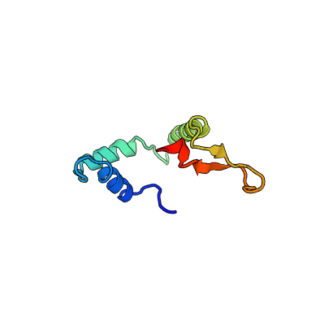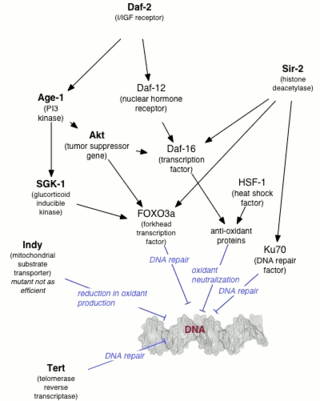Related Research Articles

Isoleucine (symbol Ile or I) is an α-amino acid that is used in the biosynthesis of proteins. It contains an α-amino group (which is in the protonated −NH+3 form under biological conditions), an α-carboxylic acid group (which is in the deprotonated −COO− form under biological conditions), and a hydrocarbon side chain with a branch (a central carbon atom bound to three other carbon atoms). It is classified as a non-polar, uncharged (at physiological pH), branched-chain, aliphatic amino acid. It is essential in humans, meaning the body cannot synthesize it. Essential amino acids are necessary in the human diet. In plants isoleucine can be synthesized from threonine and methionine. In plants and bacteria, isoleucine is synthesized from pyruvate employing leucine biosynthesis enzymes. It is encoded by the codons AUU, AUC, and AUA.
Life extension is the concept of extending the human lifespan, either modestly through improvements in medicine or dramatically by increasing the maximum lifespan beyond its generally-settled limit of 125 years. Several researchers in the area, along with "life extensionists", "immortalists", or "longevists", postulate that future breakthroughs in tissue rejuvenation, stem cells, regenerative medicine, molecular repair, gene therapy, pharmaceuticals, and organ replacement will eventually enable humans to have indefinite lifespans through complete rejuvenation to a healthy youthful condition (agerasia). The ethical ramifications, if life extension becomes a possibility, are debated by bioethicists.
Maximum life span is a measure of the maximum amount of time one or more members of a population have been observed to survive between birth and death. The term can also denote an estimate of the maximum amount of time that a member of a given species could survive between birth and death, provided circumstances that are optimal to that member's longevity.
Gluconeogenesis (GNG) is a metabolic pathway that results in the biosynthesis of glucose from certain non-carbohydrate carbon substrates. It is an ubiquitous process, present in plants, animals, fungi, bacteria, and other microorganisms. In vertebrates, gluconeogenesis occurs mainly in the liver and, to a lesser extent, in the cortex of the kidneys. It is one of two primary mechanisms – the other being degradation of glycogen (glycogenolysis) – used by humans and many other animals to maintain blood sugar levels, avoiding low levels (hypoglycemia). In ruminants, because dietary carbohydrates tend to be metabolized by rumen organisms, gluconeogenesis occurs regardless of fasting, low-carbohydrate diets, exercise, etc. In many other animals, the process occurs during periods of fasting, starvation, low-carbohydrate diets, or intense exercise.

Metformin, sold under the brand name Glucophage, among others, is the main first-line medication for the treatment of type 2 diabetes, particularly in people who are overweight. It is also used in the treatment of polycystic ovary syndrome. It is sometimes used as an off-label adjunct to lessen the risk of metabolic syndrome in people who take antipsychotics. Metformin is not associated with weight gain and is taken by mouth.
A low-protein diet is a diet in which people decrease their intake of protein. A low-protein diet is used as a therapy for inherited metabolic disorders, such as phenylketonuria and homocystinuria, and can also be used to treat kidney or liver disease. Low protein consumption appears to reduce the risk of bone breakage, presumably through changes in calcium homeostasis. Consequently, there is no uniform definition of what constitutes low-protein, because the amount and composition of protein for an individual with phenylketonuria would differ substantially from one with homocystinuria or tyrosinemia.
The DAF-2 gene encodes for the insulin-like growth factor 1 (IGF-1) receptor in the worm Caenorhabditis elegans. DAF-2 is part of the first metabolic pathway discovered to regulate the rate of aging. DAF-2 is also known to regulate reproductive development, resistance to oxidative stress, thermotolerance, resistance to hypoxia, and resistance to bacterial pathogens. Mutations in DAF-2 and also Age-1 have been shown by Cynthia Kenyon to double the lifespan of the worms. In a 2007 episode of WNYC’s Radiolab, Kenyon called DAF-2 "the grim reaper gene.”
Calorie restriction is a dietary regimen that reduces the energy intake from foods and beverages without incurring malnutrition. The possible effect of calorie restriction on body weight management, longevity, and aging-associated diseases has been an active area of research.

The mammalian target of rapamycin (mTOR), also referred to as the mechanistic target of rapamycin, and sometimes called FK506-binding protein 12-rapamycin-associated protein 1 (FRAP1), is a kinase that in humans is encoded by the MTOR gene. mTOR is a member of the phosphatidylinositol 3-kinase-related kinase family of protein kinases.

A branched-chain amino acid (BCAA) is an amino acid having an aliphatic side-chain with a branch. Among the proteinogenic amino acids, there are three BCAAs: leucine, isoleucine, and valine. Non-proteinogenic BCAAs include 2-aminoisobutyric acid and alloisoleucine.
The CRON-diet is a nutrient-rich, reduced calorie diet developed by Roy Walford, Lisa Walford, and Brian M. Delaney. The CRON-diet involves calorie restriction in the hope that the practice will improve health and retard aging, while still attempting to provide the recommended daily amounts of various nutrients. Other names include CR-diet, Longevity diet, and Anti-Aging Plan. The Walfords and Delaney, among others, founded the CR Society International to promote the CRON-diet.
Leonard Pershing Guarente is an American biologist best known for his research on life span extension in the budding yeast Saccharomyces cerevisiae, roundworms, and mice. He is a Novartis Professor of Biology at the Massachusetts Institute of Technology.

Michael Ristow is a German medical researcher who has published influential articles on biochemical aspects of mitochondrial metabolism and particularly the possibly health-promoting role of reactive oxygen species in diseases like type 2 diabetes, obesity and cancer, as well as general aging due to a process called mitohormesis.

Sirtuin 1, also known as NAD-dependent deacetylase sirtuin-1, is a protein that in humans is encoded by the SIRT1 gene.

SRT-1720 is an experimental drug that was studied by Sirtris Pharmaceuticals intended as a small-molecule activator of the sirtuin subtype SIRT1. The compound has been studied in animals, but safety and efficacy in humans have not been established.

DAF-16 is the sole ortholog of the FOXO family of transcription factors in the nematode Caenorhabditis elegans. It is responsible for activating genes involved in longevity, lipogenesis, heat shock survival and oxidative stress responses. It also protects C.elegans during food deprivation, causing it to transform into a hibernation - like state, known as a Dauer. DAF-16 is notable for being the primary transcription factor required for the profound lifespan extension observed upon mutation of the insulin-like receptor DAF-2. The gene has played a large role in research into longevity and the insulin signalling pathway as it is located in C. elegans, a successful ageing model organism.

mTORC1, also known as mammalian target of rapamycin complex 1 or mechanistic target of rapamycin complex 1, is a protein complex that functions as a nutrient/energy/redox sensor and controls protein synthesis.
mTOR Complex 2 (mTORC2) is an acutely rapamycin-insensitive protein complex formed by serine/threonine kinase mTOR that regulates cell proliferation and survival, cell migration and cytoskeletal remodeling. The complex itself is rather large, consisting of seven protein subunits. The catalytic mTOR subunit, DEP domain containing mTOR-interacting protein (DEPTOR), mammalian lethal with sec-13 protein 8, and TTI1/TEL2 complex are shared by both mTORC2 and mTORC1. Rapamycin-insensitive companion of mTOR (RICTOR), mammalian stress-activated protein kinase interacting protein 1 (mSIN1), and protein observed with rictor 1 and 2 (Protor1/2) can only be found in mTORC2. Rictor has been shown to be the scaffold protein for substrate binding to mTORC2.

Genetics of aging is generally concerned with life extension associated with genetic alterations, rather than with accelerated aging diseases leading to reduction in lifespan.
Rafael de Cabo is a Spanish scientist and Branch Chief of the Translational Gerontology Branch at the National Institute on Aging, a division of the U.S. National Institutes of Health. His research on calorie restriction in rhesus macaques suggested that calorie restriction in monkeys have no significant effects on their lifespan. In 2011, his research on obese mice suggested that resveratrol mimetic helps extend longevity and his research on male mice suggested that metformin have a longevity effect.
References
- 1 2 Nikolai, Sibylle; Pallauf, Kathrin; Huebbe, Patricia; Rimbach, Gerald (22 September 2015). "Energy restriction and potential energy restriction mimetics". Nutrition Research Reviews. 28 (2): 100–120. doi: 10.1017/S0954422415000062 . PMID 26391585 . Retrieved 8 November 2015.
- 1 2 3 Lane MA; Ingram DK; Roth GS (Winter 1998). "2-Deoxy-D-glucose feeding in rats mimics physiologic effects of calorie restriction". J Anti-Aging Med. 1 (4): 327–37. doi:10.1089/rej.1.1998.1.327.
- ↑ de Magalhaes, JP; Wuttke, D; Wood, SH; Plank, M; Vora, C (2012). "Genome-environment interactions that modulate aging: powerful targets for drug discovery". Pharmacol Rev. 64 (1): 88–101. doi:10.1124/pr.110.004499. PMC 3250080 . PMID 22090473.
- 1 2 3 4 5 Ingram, DK; Roth, GS (Feb–Mar 2011). "Glycolytic inhibition as a strategy for developing calorie restriction mimetics". Experimental Gerontology. 46 (2–3): 148–54. doi:10.1016/j.exger.2010.12.001. PMID 21167272. S2CID 5634847.
- ↑ Bass TM, Weinkove D, Houthoofd K, Gems D, Partridge L (October 2007). "Effects of resveratrol on lifespan in Drosophila melanogaster and Caenorhabditis elegans". Mech. Ageing Dev. 128 (10): 546–52. doi:10.1016/j.mad.2007.07.007. PMID 17875315. S2CID 1780784.
- ↑ Kaeberlein, Matt; Thomas McDonagh; Birgit Heltweg; Jeffrey Hixon; Eric A. Westman; Seth D. Caldwell; Andrew Napper; Rory Curtis; Peter S. DiStefano; Stanley Fields; Antonio Bedalov; Brian K. Kennedy (April 29, 2005). "Substrate specific activation of sirtuins by resveratrol". Journal of Biological Chemistry. 280 (17): 17038–17045. doi: 10.1074/jbc.M500655200 . PMID 15684413.
- ↑ Zou, S; Carey JR; Liedo P; Ingram DK; Müller HG; Wang JL; Yao F; Yu B; Zhou A (Jun–Jul 2009). "The prolongevity effect of resveratrol depends on dietary composition and calorie intake in a tephritid fruit fly". Experimental Gerontology. 44 (6–7): 472–6. doi:10.1016/j.exger.2009.02.011. PMC 3044489 . PMID 19264118.
- ↑ Pearson KJ, Baur JA, Lewis KN, Peshkin L, Price NL, Labinskyy N, Swindell WR, Kamara D, Minor RK, Perez E, Jamieson HA, Zhang Y, Dunn SR, Sharma K, Pleshko N, Woollett LA, Csiszar A, Ikeno Y, Le Couteur D, Elliott PJ, Becker KG, Navas P, Ingram DK, Wolf NS, Ungvari Z, Sinclair DA, de Cabo R (August 2008). "Resveratrol delays age-related deterioration and mimics transcriptional aspects of dietary restriction without extending life span". Cell Metab. 8 (2): 157–68. doi:10.1016/j.cmet.2008.06.011. PMC 2538685 . PMID 18599363.
- 1 2 Miller RA, Harrison DE, Astle CM, Baur JA, Boyd AR, de Cabo R, Fernandez E, Flurkey K, Javors MA, Nelson JF, Orihuela CJ, Pletcher S, Sharp ZD, Sinclair D, Starnes JW, Wilkinson JE, Nadon NL, Strong R (February 2011). "Rapamycin, but not resveratrol or simvastatin, extends life span of genetically heterogeneous mice". J. Gerontol. A Biol. Sci. Med. Sci. 66 (2): 191–201. doi:10.1093/gerona/glq178. PMC 3021372 . PMID 20974732.
- 1 2 Strong, Randy; Richard A. Miller; Clinton M. Astle; Joseph A. Baur; Rafael de Cabo; Elizabeth Fernandez; Wen Guo; Martin Javors; James L. Kirkland; James F. Nelson; David A. Sinclair; Bruce Teter; David Williams; Nurulain Zaveri; Nancy L. Nadon; David E. Harrison (January 2013). "Evaluation of Resveratrol, Green Tea Extract, Curcumin, Oxaloacetic Acid, and Medium-Chain Triglyceride Oil on Life Span of Genetically Heterogeneous Mice". J Gerontol A Biol Sci Med Sci. 68 (1): 6–16. doi:10.1093/gerona/gls070. PMC 3598361 . PMID 22451473.
- ↑ da Luz, PL; Tanaka L; Brum PC; Dourado PM; Favarato D; Krieger JE; Laurindo FR (September 2012). "Red wine and equivalent oral pharmacological doses of Resveratrol delay vascular aging but do not extend life span in rats". Atherosclerosis. 224 (1): 136–42. doi:10.1016/j.atherosclerosis.2012.06.007. PMID 22818625.
- ↑ Dhahbi, JM; Mote PL; Fahy GM; Spindler SR (Nov 17, 2005). "Identification of potential caloric restriction mimetics by microarray profiling". Physiol Genomics. 23 (3): 343–50. CiteSeerX 10.1.1.327.4892 . doi:10.1152/physiolgenomics.00069.2005. PMID 16189280.
- ↑ Arkad'eva, A.V.; Mamonov, A.A.; Popovich, I.G.; Anisimov, V.N.; Mikhel'son, V.M.; Spivak, I.M. (2011). "Metformin slows down ageing processes at the cellular level in SHR mice". Tsitologiia. 53 (2): 166–74. PMID 21516824.
- ↑ Martin-Montalvo A, Mercken EM, Mitchell SJ, Palacios HH, Mote PL, Scheibye-Knudsen M, Gomes AP, Ward TM, Minor RK, Blouin MJ, Schwab M, Pollak M, Zhang Y, Yu Y, Becker KG, Bohr VA, Ingram DK, Sinclair DA, Wolf NS, Spindler SR, Bernier M, de Cabo R (Jul 31, 2013). "Metformin improves healthspan and lifespan in mice". Nature Communications. 4: 2192. Bibcode:2013NatCo...4.2192M. doi:10.1038/ncomms3192. PMC 3736576 . PMID 23900241.
- ↑ Smith, DL Jr; Elam CF Jr; Mattison JA; Lane MA; Roth GS; Ingram DK; Allison DB (May 2010). "Metformin supplementation and life span in Fischer-344 rats". J Gerontol A Biol Sci Med Sci. 65 (5): 468–74. doi:10.1093/gerona/glq033. PMC 2854888 . PMID 20304770.
- 1 2 3 Williams, D.S.; Cash, A.; Hamadani, L.; Diemer, T. (2009). "Oxaloacetate supplementation increases lifespan in Caenorhabditis elegans through an AMPK/FOXO-dependent pathway". Aging Cell. 8 (6): 765–8. doi:10.1111/j.1474-9726.2009.00527.x. PMC 2988682 . PMID 19793063.
- ↑ Haslam, J.M.; Krebs, H.A. (1968). "The permeabiliity of mitochondria to oxaloacetate and malate". Biochem J. 107 (5): 659–67. doi:10.1042/bj1070659. PMC 1198718 . PMID 16742587.
- ↑ Lee, S.m.; Dho, S.H.; Maeng, J.S.; Kim, J.Y.; Kwon, K.S. (2012). "Cytosolic malate dehydrogenase regulates senescence in human fibroblasts". Biogerontology. 13 (5): 525–36. doi:10.1007/s10522-012-9397-0. PMID 22971926. S2CID 14068141.
- ↑ Edwards, Clair B.; Copes, Neil; Brito, Andres G.; Canfield, John; Bradshaw, Patrick C. (2013). "Malate and Fumarate Extend Lifespan in Caenorhabditis elegans". PLOS ONE. 8 (3): e58345. Bibcode:2013PLoSO...858345E. doi: 10.1371/journal.pone.0058345 . PMC 3589421 . PMID 23472183.
- ↑ Spindler, S. "Diet, Drugs, Supplements and Lifespan". 2012 Health Conference Series. HealthActivator. Archived from the original on 9 April 2015. Retrieved 9 April 2015.
- ↑ Sam, Amir H.; Salem, Victoria; Ghatei, Mohammad A. (2011). "Rimonabant: From RIO to Ban". Journal of Obesity. 2011: 432607. doi: 10.1155/2011/432607 . ISSN 2090-0708. PMC 3136184 . PMID 21773005.
- ↑ Moreira, Fabrício A.; Crippa, José Alexandre S. (June 2009). "The psychiatric side-effects of rimonabant". Brazilian Journal of Psychiatry. 31 (2): 145–153. doi: 10.1590/S1516-44462009000200012 . ISSN 1516-4446. PMID 19578688.
- ↑ Lee CK, Pugh TD, Klopp RG, Edwards J, Allison DB, Weindruch R, Prolla TA (Apr 15, 2004). "The impact of alpha-lipoic acid, coenzyme Q10 and caloric restriction on life span and gene expression patterns in mice". Free Radic Biol Med. 36 (8): 1043–57. doi:10.1016/j.freeradbiomed.2004.01.015. PMID 15059645.
- ↑ Merry BJ, Kirk AJ, Goyns MH (June 2008). "Dietary lipoic acid supplementation can mimic or block the effect of dietary restriction on life span". Mech Ageing Dev. 129 (6): 341–8. doi:10.1016/j.mad.2008.04.004. PMID 18486188. S2CID 29497185.
- ↑ Spindler SR; Mote PL (2007). "Screening candidate longevity therapeutics using gene-expression arrays". Gerontology. 53 (5): 306–21. doi:10.1159/000103924. PMID 17570924. S2CID 42831700.
- ↑ Spindler SR; Mote PL; Flegal JM (Dec 2013). "Lifespan effects of simple and complex nutraceutical combinations fed isocalorically to mice". Age (Dordr). 36 (2): 705–718. doi:10.1007/s11357-013-9609-9. PMC 4039264 . PMID 24370781.
- 1 2 3 4 Minor RK, Smith DL, Sossong AM, Kaushik S, Poosala S, Spangler EL, Roth GS, Lane M, Allison DB, de Cabo R, Ingram DK, Mattison JA (Mar 15, 2010). "Chronic ingestion of 2-deoxy-D-glucose induces cardiac vacuolization and increases mortality in rats". Toxicol Appl Pharmacol. 243 (3): 332–9. doi:10.1016/j.taap.2009.11.025. PMC 2830378 . PMID 20026095.
- ↑ Schulz TJ, Zarse K, Voigt A, Urban N, Birringer M, Ristow M (2007). "Glucose restriction extends Caenorhabditis elegans life span by inducing mitochondrial respiration and increasing oxidative stress". Cell Metab. 6 (4): 280–93. doi: 10.1016/j.cmet.2007.08.011 . PMID 17908557.
- 1 2 3 Stanfel MN; Shamieh LS; Kaeberlein M; Kennedy BK (Oct 2009). "The TOR pathway comes of age". Biochim Biophys Acta. 1790 (10): 1067–74. doi:10.1016/j.bbagen.2009.06.007. PMC 3981532 . PMID 19539012.
- ↑ Harrison DE, Strong R, Sharp ZD, et al. (8 July 2009). "Rapamycin fed late in life extends lifespan in genetically heterogeneous mice". Nature. 460 (7253): 392–5. Bibcode:2009Natur.460..392H. doi:10.1038/nature08221. PMC 2786175 . PMID 19587680.
- ↑ Miller RA; Harrison DE; Astle CM; Fernandez E; Flurkey K; Han M; Javors MA; Li X; Nadon NL; Nelson JF; Pletcher S; Salmon AB; Sharp ZD; Van Roekel S; Winkleman L; Strong R (Jun 2014). "Rapamycin-Mediated Lifespan Increase in Mice is Dose and Sex-Dependent and Appears Metabolically Distinct from Dietary Restriction". Aging Cell. 13 (3): 468–77. doi:10.1111/acel.12194. PMC 4032600 . PMID 24341993.
- 1 2 Yu Z; Wang R; Fok WC; Coles A; Salmon AB; Pérez VI (April 2014). "Rapamycin and Dietary Restriction Induce Metabolically Distinctive Changes in Mouse Liver". J Gerontol A Biol Sci Med Sci. 70 (4): 410–20. doi:10.1093/gerona/glu053. PMC 4447794 . PMID 24755936.
- 1 2 Fok WC; Bokov A; Gelfond J; Yu Z; Zhang Y; Doderer M; Chen Y; Javors M; Wood WH 3rd; Zhang Y; Becker KG; Richardson A; Pérez VI (Apr 2014). "Combined treatment of rapamycin and dietary restriction has a larger effect on the transcriptome and metabolome of liver". Aging Cell. 13 (2): 311–9. doi:10.1111/acel.12175. PMC 3989927 . PMID 24304444.
{{cite journal}}: CS1 maint: numeric names: authors list (link) - ↑ Denzel MS, Storm NJ, Gutschmidt A, Baddi A, Hinze Y, Jarosch E, Sommer T, Hoppe T, Antebi A (2014). "Hexosamine pathway metabolites enhance protein quality control and prolong life". Cell. 156 (6): 1167–1178. doi: 10.1016/j.cell.2014.01.061 . PMID 24630720.
- ↑ Weimer S, Priebs J, Kuhlow D, Groth M, Priebe S, Mansfeld J, Merry TL, Dubuis S, Laube B, Pfeiffer AF, Schulz TJ, Guthke R, Platzer M, Zamboni N, Zarse K, Ristow M (2014). "D-Glucosamine supplementation extends life span of nematodes and of ageing mice". Nature Communications. 5: 3563. Bibcode:2014NatCo...5.3563W. doi:10.1038/ncomms4563. PMC 3988823 . PMID 24714520.
- ↑ Eisenberg, Tobias; Abdellatif, Mahmoud; Schroeder, Sabrina; Primessnig, Uwe; Stekovic, Slaven; Pendl, Tobias; Harger, Alexandra; Schipke, Julia; Zimmermann, Andreas (2016). "Cardioprotection and lifespan extension by the natural polyamine spermidine". Nature Medicine. 22 (12): 1428–1438. doi:10.1038/nm.4222. PMC 5806691 . PMID 27841876.